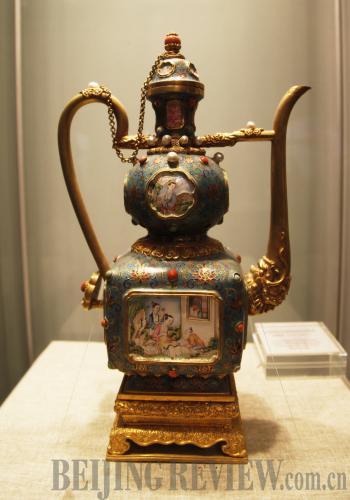|
 |
|
COURT TREASURE: An enamel vessel of the Qing Dynasty (1644-1911) displayed in the Palace Museum in Beijing (CFP) |
One of the most significant events brought about by the earlier contract was the Louvre Museum NapoleonⅠExhibition, which took place at the Palace Museum from April 5 to July 3 in 2008. During the exhibition, about 100 exhibits relating to Napoleon were on show. All exhibits were provided by the Louvre Museum.
"Besides the Napoleon exhibition, cooperation and communication on management experience and publishing will also be emphasized. Nowadays, greater numbers of Chinese tourists are visiting the Louvre. In order to offer them better service, the Louvre cooperates with Chinese museums so they have a better understanding of what is needed. Cooperation with the Palace Museum is bound to help us make progress in that area," said Christophe Monin, Deputy Director of Cultural Development of the Louvre Museum, in 2006.
As the most famous and largest museums in the world, the Palace Museum and the Louvre Museum share a lot in common: They both used to be palaces and inherited many antiquities; both museums take palace art works as their basis and have gradually expanded their collections; both of them have abundant collections; both play an irreplaceable role in developing and promoting their cultures; both receive many domestic and foreign tourists each year. As well, they have encountered similar questions recently, such as how to ensure service while receiving so many tourists, how to protect ancient architecture, and how to publicize their cultures.
The Palace Museum said there was considerable significance in strengthening cooperation with foreign museums. It would help publicize Chinese culture and will be very important for the Palace Museum to use others' experience for reference in order to improve itself. Apart from the Louvre Museum, the Palace Museum also has cooperative relationship with eight other foreign museums, including the British Museum, the Metropolitan Museum of Art in New York, and the Tokyo National Museum.
The Louvre Museum
Originally constructed from 1165 to 1223, the Louvre was built as a palace for aristocrats. As the heir to the century of the Enlightenment and the French Revolution, the museum is now accepted as the "museum among museums," a model and a recognized authority.
Founded in 1793 as a museum for all, the Louvre celebrates humanity's long journey spanning thousands of years, reaching from America to the borders of India and China, and is highlighted by such iconic, universally admired works as the Mona Lisa, the Venus de Milo and the Victory of Samothrace.
Together with the British Museum and the Metropolitan Museum of Art, the Louvre, now a public and multifaceted institution, is recognized as one of the top three museums in the world. It now houses 35,000 works of art in eight departments, displayed in more than 60,000 square meters of exhibition space. Its curatorial departments include Near Eastern Antiquities, Islamic Art, Paintings, Egyptian Antiquities, Sculptures, Prints and Drawings, Greek, Etruscan and Roman Antiquities, and Decorative Arts.
(Source: lourve.fr)
The Palace Museum
Located in the center of Beijing, the Palace Museum was established on the base of the Forbidden City, a royal palace of the Ming and Qing dynasties, and its collection of treasures. Founded in 1925, the museum is the largest museum of the country.
The museum houses a collection of more than 1.5 million valuable art works, most of which were in the possession of the imperial families of the Ming and Qing dynasties. These art treasures include painting, pottery; bronze, gold and silverware; embroidery, sculpture, jade, lacquer and enamel wares. In addition, there are also court articles, including jewels, accessories, clocks, medicines, furniture and furnishings. It is a unique, superb building complex, integrating outstanding achievements of ancient Chinese architecture.
In 1961, the Forbidden City was included in the List of Key Historical Monuments under State Protection. In 1987, it was put on the World Heritage List of the UNESCO. The Palace Museum used to be as mysterious as the palace itself. But now, with advanced technology and equipment it has built a "digital palace" on the Internet, to unveil its tremendous cultural resources.
(Source: dpm.org.cn) |
